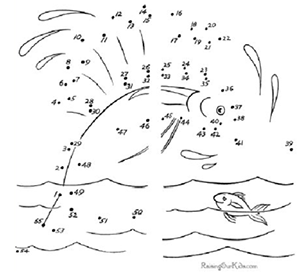I always feel so enthusiastic when I register for a new training session. I know I am not alone in this feeling and that there are many people that share the same sentiment. Just knowing that the new version of ITIL just launched, or that SAFe has progressed from 4.5 to 4.6, or as a DASA Ambassador the competency schema continues to evolve as the DevOps industry takes shape brings me a high level of excitement. I guess I am naïve and overly optimistic. I feel that the minds behind all these great industry proven methodologies have somehow unlocked the secrets to transform individuals and organizations. They are the great magician, and I am the onlooker wondering and wanting to learn all the new tricks.
I liken the training experience to a connect-the-dot puzzle. In a simple connect-the-dot puzzle, it can be pretty easy to deduce what the resulting picture will be. We can easily trace the dots within our mind, going from one to the other in a seamless manner to construct the image.

Did you guess the image was a fish?
Like a connect-the-dots puzzle, three-day training courses package all the material in a manner that is very easy to understand and comprehend. The majority of terms and concepts are intentionally taught in isolation to ensure that the information is retained. Example scenarios are used to teach problem solving based on realistic situations. The instructor gives lessons learned based on their experience so you (the class participant) can get a full understanding of how the material is applied in the real world.
Like most people, I leave energized when the class is over. I feel eager to go back to my organization and put all my new-found knowledge into practice. Each day I look for a new opportunity to share the knowledge I gained and become the catalyst in the transformation of my organization. And as each day passes, my enthusiasm light dims and instead of being a catalyst, over time I succumb to the status quo. What once was a simplistic connect the dot puzzle has turned into a cluster of random dots with no beginning or end. I am left thinking why I had this naïve perspective that a quick remedy training course would give me the tools to fix all the problems in my organization.

This complex connect-the-dots puzzle represents the true nature of our organizations and trying to apply the newly acquired knowledge into practice. Where to begin is not as well pronounced as it was during the training class. Navigating through each step is quite confusing. And the known and unknown variables have to be constantly managed. It is hard to have a clear vision of what the end goal is and what it will look like. This illusion has created a large gap between the picture that was painted during the training seminar and true reality.
This gap can be explained by research conducted by Dr. Faria Sana from the Athabasca University in Canada. During a training seminar, most people experience the feeling of fluency. The feeling of fluency, or processing fluency theory, states that there is a positive correlation between the ease that an individual has with processing information and their feeling of having a high comprehension of that information. It is an internal cue that assesses an individual’s current state of comprehension. But it can be very deceptive. The leading theory in this area of research concluded that people rarely become aware of their own self-awareness when they learn something new. Instead, they assess how well they comprehend information based on predictive learning outcomes.
Let me provide an explanation. When most people first learn and understand the rules of chess, they believe they know how to play the game. It isn’t until they play a chess master and are checkmated in four moves do they truly realize they have more to learn in the game. It is the difference between learning for comprehension and learning for application. Learning for application takes intention and diligence throughout the learning process.
Typically, the participant is partaking in training that is relevant to their profession. They absorb the information and can easily place it into context of what they already know. During the training, the participant is conducting data recall to find relevant experiences. This results in the participant filling in the gap based on their experiences for anything that is not explicitly stated so the material makes logical sense to them. This act of processing the information does introduce some subjectivity and causes the individual to feel a high level of comprehension without true insight into application.
Pfeffer and Sutton wrote in their book, The Knowing-Doing Gap, “that we as individuals treat knowledge as a tangible thing, like an innate object. But knowledge is not useful until it is applied.” These researchers laid out the foundation to solve this issue.
We must apply the knowledge. And you, like most people, quickly resort to thinking “that was what I was trying to do in the first place.” But were you truly applying the knowledge or just trying to comprehend it and demonstrate that comprehension? Applying the knowledge requires intention while learning. I use a simple trick anytime I take a training course that has helped me to have the ability to apply all knowledge that I have obtained through training:
- After each major concept, I write down an organizational problem where it could be applied and draft a detailed process on how to execute it.
- I review the process and document any unknowns or questions that need to be answered in order to execute the plan.
- I take the process and those questions back to the trainer and discuss potential solutions and blind spots that I did not consider.
This simple three step approach forces me to think about how to apply the knowledge in a relevant situation while I have the expert on hand for their opinion. By simply doing this for every major concept taught, I have witnessed tangible results in my organizations.
Were you truly applying the knowledge or just trying to comprehend it?

Try it for your next training seminar. Let me know if it works. Provide me your insight, and we can keep the conversation going. Find me on LinkedIn, and let’s talk about it.
Dr. Alma Miller is an enthusiastic entrepreneur, speaker, and educator with more than 15 years of experience in the IT industry. She holds a Bachelor’s degree in Electrical Engineering from Catholic University, a Masters in Electrical Engineering from George Washington University, a Masters in Technical Management from Johns Hopkins University, and a Doctorate in Engineering from George Washington University. Dr. Miller considers herself a relationship counselor between development and IT operations teams. Her consulting company,
AC Miller Consulting
, provides services to government and commercial clients across multiple industries. Dr. Miller speaks at industry conferences and events and teaches graduate courses for Johns Hopkins and University of California Irvine. Connect with her on
LinkedIn
to continue the conversation.